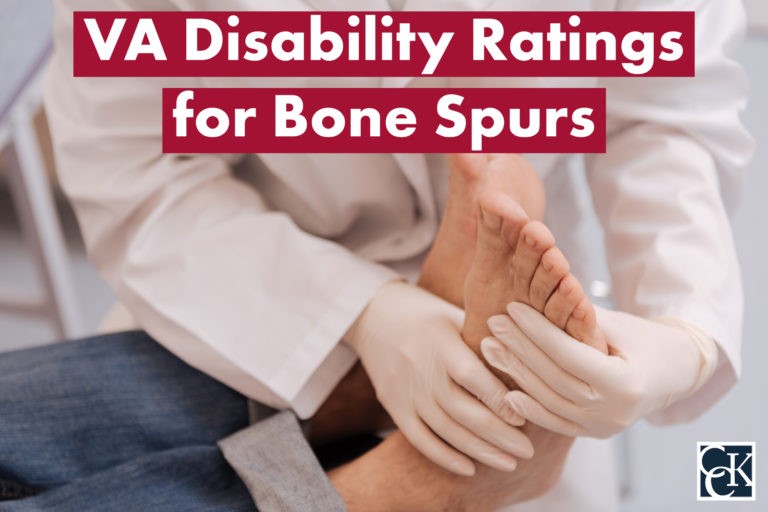VA Disability Ratings for Bone Spurs

CCK Law: Our Vital Role in Veterans Law
Bone spurs are a very painful condition that often interferes with a person’s life. Many veterans develop this condition as the result of their military service and may be eligible for VA disability service. Continue reading to learn more about what benefits you may qualify for if you are a veteran suffering from service-related bone spurs.
What are Bone Spurs?
Although bone spurs can form on any bone, they typically form on joints where two bones come together, or where bones connect to ligaments or tendons. When this happens, a bony growth can form. These growths can be smooth, but still cause pain and undue wear and tear.
What Causes Bone Spurs?
Spurs on the bone can occur as the result of osteoarthritis. They can also occur when a ligament or tendon pulls too hard or when the body heals itself after an injury.
Most commonly, they can form in the following areas:
- Heels
- Knees
- Hips
- Spine
- Neck
- Shoulders
- Elbows
For example, bone spurs in the feet can develop from activities that place stress on the feet, like running, wearing tight shoes, or overuse.
Symptoms of Bone Spurs
Many people have bone spurs and never realize it because bone spurs can occur without any symptoms. However, when bone spurs press on other bones or tissues, or rub a muscle or tendon, they can break down important tissue. This can cause swelling, pain, and tearing.
If bone spurs occur in the foot, they can create corns and calluses, as tissue builds up to provide protective padding over the bone spur.
How Are They Diagnosed?
As bone spurs are usually made of bone, they can be detected with an X-ray. However, while not difficult to detect, these often go undiagnosed due to the lack of symptoms.
How Are They Treated?
To treat bone spurs, doctors may first need to treat the underlying cause in order to alleviate symptoms. A physical therapist may be needed to help relieve pain in some areas, such as if the person is experiencing plantar fasciitis.
Other methods could include weight loss, protective footwear or shoe inserts, or medication for osteoarthritis. Additionally, bone spurs can sometimes be surgically removed.
Getting Service Connection for Bone Spurs
To establish service connection for bone spurs, veterans will need to fill out and submit VA Form 21-526, Application for Disability Compensation and Related Compensation Benefits. Veterans can submit the form online using the eBenefits platform, through the mail, in person at the nearest VA Regional Office, or with the help of an accredited legal representative.
When filing a claim for service connection, veterans will need to submit:
- A current diagnosis;
- An in-service event or stressor which caused or aggravated the condition; and
- A nexus, which links the veteran’s condition to their service
Often, veterans can receive secondary service connection for bone spurs if they are related to another condition, such as osteoarthritis. In order to be eligible for secondary service connection, the veteran’s bone spurs need to be caused or aggravated by another condition. To prove this, veterans will need to first become service connected for their primary condition, or the condition that caused their bone spurs, and then submit the following to VA:
- A current diagnosis of bone spurs; and
- Medical evidence demonstrating the link between the veteran’s primary service-connected condition and their bone spurs
Veterans will use the same form (VA Form 21-526) to file for secondary service connection.

VA Compensation and Pension Exams
After filing a claim, VA may request that veterans attend a Compensation and Pension exam. Compensation & Pension exams are designed to evaluate whether your condition was caused by your military service and to gather evidence to assign a disability rating if service connection is granted.
The exam is usually performed by a VA-contracted examiner. During the exam, the examiner may take X-rays to examine your bone spurs, as well as to see connections with any other conditions such as osteoporosis. The examiner may ask you about symptoms of your condition or your time in-service. For example, if you believe your spurs are the result of a foot injury healing improperly, the examiner may ask for specific details about that injury. It is best to come to the exam prepared to talk about both your military service and your condition.
It is also important to attend an exam if you are scheduled for one. If you do not attend your exam, VA could deny your claim. If you have a conflict with an already scheduled exam, or if you find out you missed an exam, you should contact VA as soon as possible to see if you can reschedule.
How Does VA Rate Bone Spurs?
There is no specific diagnostic code used to rate bone spurs, meaning that they are rated analogously. Analogous ratings are ratings given to conditions that are not explicitly included in VASRD. These ratings are assigned based on what condition most closely matches the overall symptoms or treatment of the disability that VA is trying to rate.
For example, VA may rate bone spurs under Diagnostic Code 5279, which is generally used to rate Metatarsalgia, or Morton’s Disease. If a veteran is rated under this diagnostic code, the highest rating they can receive, whether their spurs affect one or both feet, is 10 percent.
If your bone spurs are located in your spine, VA may rate your condition as analogous to back pain.
TDIU for Bone Spurs
Any rating a veteran receives for bone spurs, whether through primary or secondary service connection, can contribute to a veteran’s eligibility for TDIU. TDIU, or total disability based on individual unemployability, is a monthly benefit for veterans who are prevented from working because of their service-connected disabilities.
In order to be eligible for schedular TDIU, veterans must meet the criteria listed under 38 CFR § 4.16a. The criteria stipulate that veterans must have one condition rated at 60 percent minimum OR two conditions that can be combined to reach 70 percent, where one condition is at a minimum of 40 percent.
If veterans do not meet the above criteria, they may be eligible extraschedular TDIU. For this form of TDIU, veterans must prove that their condition(s) uniquely hinders their ability to maintain substantially gainful employment. Extraschedular TDIU is rated under 38 CFR § 4.16b.

Need Help Getting VA Disability Benefits?
Veterans seeking VA disability compensation for bone spurs may have difficulties throughout the claims and appeals process. Specifically, as this condition is not rated with one specific diagnostic code, veterans may have trouble establishing service connection.
If you need accredited representation to help guide you through your appeal for VA disability benefits, Chisholm Chisholm & Kilpatrick may be able to help. Our experienced team has helped many veterans win the benefits they deserve. Call today for a free case evaluation.
About the Author
Share this Post
